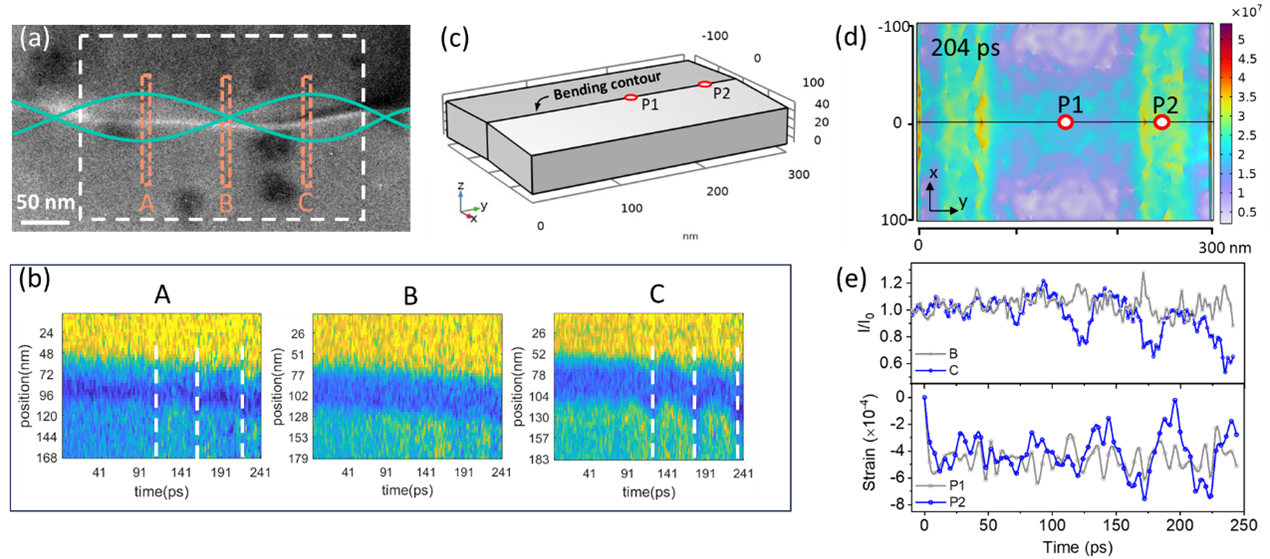
Standing wave in a line defect of the Weyl semimetal WTe2. (a) Image of sample with a line defect, the green curved lines indicate the positions of nodes and antinodes, the orange regions labeled A-C indicate the positions of the line profiles for the space-time contour plots (STCPs) in (b), the white dashed rectangle represents the region for simulation. (b) SCTPs generated from orange outlined regions A, B and C in (a). The white dashed lines indicate the times of strongest oscillation. (c) the model used in the COMSOL simulation. The sample is bent 3 degrees from horizontal to form a bend contour. (d) Simulated snapshot of stress profile at 204 ps in the x-y plane of the sample, the unit of scale bar is N/m2, the black line in center represents the position of the defect, P1 and P2 indicate two positions where the strain is plotted for in (e). (e) The upper panel shows the experimental change in pixel intensity at regions B and C, the lower panel shows the simulated volumetric strain at positions P1 and P2.
Ultrafast imaging of photo-induced phonon dynamics in a Weyl semimetal
Topological quantum materials are unique solid-state systems, characterized by robust boundary states and quantized bulk response coefficients as a consequence of their electronic wavefunctions. This distinctive trait positions them as promising platforms for storing and manipulating quantum information. Lattice strain provides a natural means of tuning these topological invariants because it directly modifies the electron–ion interactions and potentially alters the underlying crystalline symmetry on which the topological properties depend.
However, modulation of strain is conventionally performed through the application of static pressure, which pose challenges in probing and manipulating transient topological states. Light–matter interaction in 2D and topological materials provides a fascinating control mechanism for inducing emergent, non-equilibrium properties and achieving new functionalities on ultrafast timescales, in picoseconds or even femtoseconds. Upon the excitation with ultrashort pulsed light, energy is transferred from the light-absorbing electron subsystem to the lattice through electron-phonon scattering, resulting in coherent atomic displacements at short time scales. The ARTEMI ultrafast electron microscope (UEM) is a suitable platform to perform experiments which requires high-temporal-spatial resolution.
This study delves into the exploration of transient structural deformation and strain dynamics at microscopic locations of intrinsic strain in the Weyl semimetal WTe2. The intrinsic strain field is represented by a local bend of the sample, and transient structure deformation is achieved through femtosecond pulsed laser-induced phonons. We observe the phonon dynamics at the bending defect, which results in a superposition of acoustic phonons and formation of local standing waves. We demonstrate that periodic strain modulations, manifested through deformations on a nanometer scale, can be controlled by optical excitation. The phonon-strain modulation method lays the groundwork for achieving the predicted mixed axial-torsional anomaly and acoustogalvanic effect in Weyl semimetals.
This work has been performed by PhD. student Jianyu Wu, and Post doc. Amit Kumar Prasad. The project is supervised by Prof. Jonas Weissenrieder.
